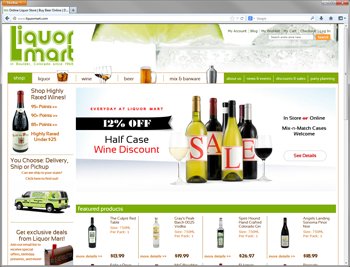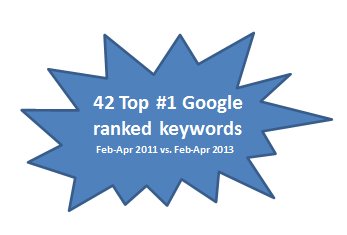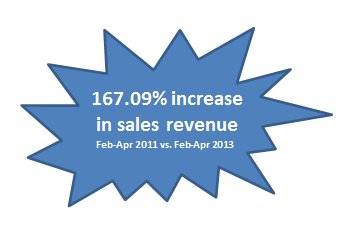
Client Name: Liquor Mart
Client Website: http://www.LiquorMart.com/
Client Type: Brick & Mortar Retailer + eCommerce
Industry: Wine, Beer & Spirits
Project Type: Organic Search Engine Optimization
Project Start: February 2011 - Present
Level of Search Competition: Project started as Low competition
for the space, with high effort. Recently, more competitors have moved into
the space, resulting in high competition for their space.
Level of Effort Required: High level of effort was expended
(50 hours per month), resulting in a domination of the category.
Campaign Goals: Increase sales of Liquor, wine and beer online; drive additional traffic to retail store.
Liquor Mart is an institution in Boulder, Colorado, and is the city's largest
brick and mortar retailer of wine, beer and spirits. Customer Paradigm helped
achieve 42 different Top #1 Google keyword ranking results, increase revenue
by 167%, and increase visitors to the site
during this time by 245%. Type in "liquor" into Google, and Liquor
Mart is the #1 result, ahead of Wikipedia.
Liquor Mart began search engine optimization efforts when the space was low competition, and poured a significant amount of resources (50 hours per month) into the campaign. As a result, they dominated the keyword terms. Two years later, the space is more competitive, but their previous investment in SEO has allowed them to maintain their top position, as well as decrease the number of hours spent on active SEO to 10 hours per month.
Key Stats:
Feb - April 2011 vs. Feb - April 2013:
245.10% increase in visitors
277.41% increase in unique visitors
167.09% increase in revenue
171.83% increase in sales quantity



We achieved #1 Google rankings for these keywords:
First, A Disclaimer:
Why are we sharing this case study? Aren't we giving away our "secret"
keys to success with this information? No. Everything that we do is transparent.
It takes a lot of hard work, high level strategy and persistence to generate
top results. Search Engine Marketing changes very week, too, so part of what
makes us successful is that we stay current on new trends. What worked well
two years ago... might not work well today, and might even hurt your search
efforts. So take everything that we're saying with a grain of salt and realize
that what we've done with this client might not work with someone else.
Second, Another Disclaimer:
Strong organic SEO takes time. Results are not immediate. Anyone that promises
that they've cracked the Google code and get can you top #1 rankings in just
a month is setting a false expectation. This is a case study for work that started
in February 2011. Progress was incremental. We chipped away, a little bit at
a time, followed the rules, and saw strong results. If you need immediate sales
or traffic to your site, paid advertising will deliver results more quickly,
but over time it can become a crutch. SEO is like farming. You plant seeds each
week, water and tend them carefully, and a few months later, some of them will
sprout into bountiful fruit. For this client, two and a half years later, we're
still chipping away, seeing improvement, and not sliding backward - even as
the space becomes more and more competitive.
Prior to Starting, I Checked to Make Sure Selling Liquor, Wine
& Beer
Online Was Legal:
Before we even got started, I checked with the state of Colorado to make sure
that we weren't going to get in trouble. My great grandfather was a
bootlegger during Prohibition in Cheyenne, Wyoming. But I wanted to make sure
that what we were doing, including shipping wine to 17 other states,
wouldn't get us or the client in trouble.
Liquor, Wine and Beer laws in the state of Colorado date back to the Prohibition
era, and are very strict. For example, Colorado law prohibits "chains"
of Liquor stores. You literally cannot open a second store with the same name
and ownership structure. (This is one reason why Colorado tends to have a lot
of larger-scale Liquor stores.) Another rule prohibits a liquor store from having
their warehouse located at another (less expensive) location.
Once I got the "all clear" from the state of Colorado, we proceeded to help out with the site.
Liquor Mart built their eCommerce site on the Magento Commerce platform. Magento has a 26% market share in the Alexa Top 1 Million eCommerce sites, and is a dominant eCommerce platform in the industry.
Before we did any work on the site, we ran a baseline SEO report to establish how the site ranked for various keywords, how many inbound links the site had, and it's domain authority and other important metrics. That way, we could make sure that the changes we made had an effect (positive or negative).
We also ran a competitive analysis, to see how the current website performed against their top five competitors. This helped us know what keywords to focus on, and where there was room for improvement.
We found that Liquor Mart had a very strong domain name, and had already spent time establishing themselves as a trusted vendor. They shipped wine to 17 states across the US, and had spent considerable expense putting all of their products onto their site in an eCommerce platform.
The site loaded quickly, and they had invested in a solid web hosting plan. Finally, the client realized that the website wouldn't cannibalize their brick and mortar business. With free local delivery, the site could help reach more local customers -- especially ones that didn't want to hop in their car and drive 10-15 minutes to get the hard-to-find products they'd come to enjoy.
Before we started active SEO work, we first wanted to make sure that there weren't any structural problems with the site that could prevent a search engine like Google from being able to index the site properly.
We ran a crawl report on the site, and found a few issues:
Magento is a full-featured eCommerce package, but some features, including making sure pages are cononicalized, need to be set up properly.
We made sure that category pages, for example, used the relative "previous" and "next" tags, so that all of the category pages would be indexed completely.
Once this was complete, we re-ran the crawl report to make sure that the site was "ready" for active SEO work.
We also verified that statistics tracking and analytics were working properly on the site.
The tracking and measurement code that allowed us to analyze who was coming to the site, how they were getting there, and if they were making a purchase, downloading a coupon, or filling out a contact form.
Many companies prefer to use guess work to generate a list of SEO keywords that they "feel" will generate good results.
At Customer Paradigm, we prefer to use real data to test assumptions instead.
It's easy to generate traffic to a site. It's much harder to know what keywords actually generate sales.
We created several small-scale Pay Per Click (PPC) campaigns using Google Adwords, and cast a wide net with keywords.
What we found were not just keywords that drove increased traffic to the site, but we were able to glean the keywords (such as Buy Beer Online) that also generated sales.
What we found was that the conversion cost (how much money it cost to have someone click on a paid ad, come to the site, and make a purchase) was in some cases greater that the amount of profit from the actual sale. Long term, Pay Per Click (PPC) via Google Adwords was discontinued, and the decision was made to focus on paid search.
But the data that we gathered help us figure out the precise keywords to target for natural, organic search engine efforts.
Some of the top terms we found included:
What we next did was separate the list of "golden" keyword terms, that we knew would drive both traffic and sales, into two categories:
As you may already know, search engines look for a lot of "signals" that indicate if a site is going to be a trustworthy resource for people searching. While Google and other search engines look at everything from page load time to the age of a domain name, the two big factors that continue to matter are:
So in this phase, we focused on making sure we had great content on the site. The content needed to be well-written, and focused on information relevant to people searching for liquor, wine and beer.
Some of the content included:
Writing in a way that is engaging to end customers, but still works properly
with search engines is a skill that takes time to master. We've trained the
client to be able to generate more of this content internally now, but for this
first phase, our writing team was creating this content
each and every week to add to the site.
Tracking and measurement is key. Each month, we chose different keywords to focus on, and measured the impact of the content changes to the site, based on high or low competitive keywords.
Next, we focused generating more quality inbound links to the site.
With Customer Paradigm's tracking system, we were able to examine the existing inbound links to the site, and create a strategy and tactical plan for getting more inbound links to the site.
This is probably the most difficult and time-consuming part of active SEO, as it requires a lot of out of the box thinking, and outreach to other site owners, bloggers and social media influencers.
For competitive reasons, I'm not able to reveal all of the details for how we were able to generate inbound links from top sites. (I can't give away all of our secrets.)
But our strategies included some of these areas:
Once we were able to generate strong content and inbound links for the site, traffic increased considerably.
But our work was not yet done.
What we did next was look at the data from the user experience, and determine where users were getting frustrated and leaving the site. In search terms this is known as a "bounce" -- they come to the site from a search engine, and then bounce back to the search results page because they didn't find what they were looking for.
We conducted A-B split testing on different pages of the site (I.e. Some of the key landing pages for high value keywords). By changing and testing graphics, messaging (I.e. Free local delivery), we were able to determine what elements of the page worked best for their customer base.
With A-B split testing, you take the emphasis off of guess work and focus on seemingly minor changes to a page, navigation or marketing message. By testing one version against the other, you're able to refine the user experience.